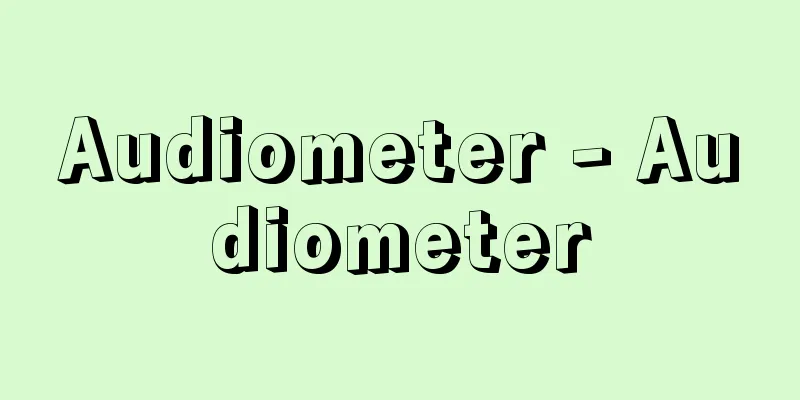Audiometer - Audiometer

|
The most widely used electrical device for hearing tests is the pure tone audiometer, which produces pure tones. The devices used to diagnose hearing loss are regulated by the Japanese Industrial Standards (JIS). They can produce pure tones of 125, 250, 500, 1000, 2000, 4000, and 8000 Hz per second, and the volume can be increased or decreased using a volume control, and the intensity of the sound is also regulated. There are two types of sound: air conduction sound produced by earphones and bone conduction sound produced by a transducer. Using these sounds, the intensity of the smallest sound that can be heard (minimum audible threshold) is measured, and hearing is calculated using air conduction sound. The basis for sound intensity is 0 decibels, which is regulated by the Japanese Industrial Standards, and is almost equal to the average minimum audible threshold of normal people. Bone conduction sound is used to diagnose hearing loss. Audiometers are also made for a variety of purposes, including self-recording audiometers, which automatically increase or decrease the volume of sound when the person being tested signals whether they can hear, and record the progress, speech audiometers, which emit speech sounds, group audiometers that can test many people at once, as well as audiometers for infants and screening audiometers. The results of measurements made with an audiometer are usually presented as a graph with frequency on the horizontal axis and sound intensity on the vertical axis; this is called an audiogram. [Masami Kawamura] [Reference] |Source: Shogakukan Encyclopedia Nipponica About Encyclopedia Nipponica Information | Legend |
|
聴力検査用の電気器具で、もっとも普及しているのは純音を出す純音オーディオメーターである。難聴診断用のものは日本工業規格(JIS(ジス))により規定されている。毎秒125、250、500、1000、2000、4000、8000ヘルツの各純音を出すことができ、音量調節器によって音量の増減も可能で、その音の強さも規定されている。音はイヤホンから出る気導音と、振導子から出る骨導音がある。この音を使って聴くことができるもっとも小さい音の強さ(最小可聴閾値(いきち))を測定し、気導音で聴力を求める。音の強さの基礎となっている0(ゼロ)デシベルは日本工業規格で定められているが、正常者の最小可聴閾値の平均値とほぼ等しい。骨導音は難聴の診断に用いる。 このほか、いろいろな目的のためにもつくられている。検査を受けている人が、聞こえているかどうかを合図すると、音が自動的に増減し、その経過が記録される自記オーディオメーター、語音を出す語音オーディオメーター、多人数を一度に検査できる集団オーディオメーター、さらに幼児用オーディオメーターや選別用オーディオメーターなどがある。 オーディオメーターで測定された結果は、周波数を横軸に、音の強さを縦軸とした図表で示されるのが普通で、これをオーディオグラムaudiogramという。 [河村正三] [参照項目] |出典 小学館 日本大百科全書(ニッポニカ)日本大百科全書(ニッポニカ)について 情報 | 凡例 |
>>: Audio High Density Disc Method
Recommend
Angiotonin
…Also called angiotonin or hypertensin. A polypep...
Gennosuke Uemura - Uemura Gennosuke
...It is said that this was done to take advantag...
Water-pollinated flower - Suibaiika
A flower in which pollen is carried to the stigma...
Campoidea larvae - Campoidea larvae
...General term for insects belonging to the Camp...
Zenkoji Temple
[1] A temple located in Nagano Motozencho, Nagano ...
Toyama [town] - Tomiyama
A former town in Awa District, southern Chiba Pref...
Ueda Castle Town
...It is a key transportation hub where the Nagan...
sutta
…The original meaning was “thread,” and it is tho...
rotary snow-plow
...railroad vehicles used for clearing snow from ...
Horned frog - Horned frog (English spelling)
A general term for frogs belonging to the genus Ce...
Lin Zhao-en (English name)
[Born] 12th year of Shotoku (1517) [Died] 1598 A C...
Congenital wheezing
It is also called congenital laryngeal stridor. A ...
Crime of endangering traffic
This is a crime that causes danger to train operat...
Ion rocket
A rocket propelled by the recoil of charged partic...
Yellow egg wasp - Yellow egg wasp
...They prefer wet grasslands such as rice paddie...









